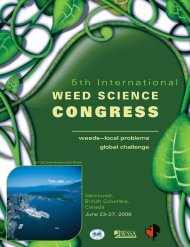PARAQUAT
PARAQUAT
PARAQUAT
You also want an ePaper? Increase the reach of your titles
YUMPU automatically turns print PDFs into web optimized ePapers that Google loves.
US EPA (1997) reported necrosis and atrophy<br />
of the testes, atrophy of the ovaries, and uterine<br />
cysts and polyps, with chronic exposure.<br />
According to Wesseling et al (2001a), animal<br />
studies revealed no reproductive effects at<br />
doses of paraquat lower than the maternal<br />
toxicity dose. Reproductive effects that were<br />
found at high rates included foetal mortality in<br />
rats, increased percentage of abnormal eggs in<br />
hens (Extoxnet 1996), and increased resorption<br />
rate and postnatal mortality rate in mice (IPCS<br />
1984; Cal EPA 1993). Hence paraquat is not<br />
expected to cause damage to reproduction<br />
at levels humans are normally exposed to<br />
(Extoxnet 1996).<br />
However, recent in vitro laboratory studies have<br />
demonstrated that paraquat, even at very low<br />
levels of exposure, may affect reproduction.<br />
Pre-implantation exposure of mouse embryos<br />
to concentrations of paraquat as low as 8 µM<br />
(the lowest concentration tested) resulted<br />
in significant reduction in their development<br />
(Hausberg et al 2005). And exposure to<br />
concentrations of paraquat 800-fold less than<br />
these injured mouse stem cells, stalling cell<br />
proliferation and increasing cell death. These<br />
effects occurred at the equivalent of the fi rst 4-6<br />
days of pregnancy and at concentrations so low<br />
(e.g. 0.014 µM) that adverse health effects are<br />
not expected (Perla et al 2008).<br />
Additionally, in 2007 Anuar Zain concluded that<br />
paraquat is in fact “toxic to male reproductive<br />
function both by oral and dermal routes of<br />
exposure”. His study showed that, in rats, medium<br />
to high levels of exposure to paraquat (5 mg/<br />
kg and 20 mg/kg) resulted in decreased organ<br />
weight; decreased diameter of seminiferous<br />
tubules; degeneration of the epididymal<br />
epithelium; decreased spermatogonia,<br />
spermatocytes, spermatids and Leydig cells;<br />
increased sperm mortality and abnormal sperm<br />
morphology; and decreases in testosterone,<br />
follicle-stimulating hormone, luteinizing hormone<br />
and prolactin.<br />
Haley (1979) reported that, when injected<br />
into fertile hen eggs, “paraquat caused<br />
pseudofeminization of male chick and quail<br />
embryos, the testes showed intersexual<br />
phenomena, and regression of the Mullerian<br />
ducts was inhibited (these normally develop in<br />
females but degenerate in males). There was<br />
a reduction in the number of gonocytes in both<br />
males and females” [germ cells responsible for<br />
formation of ova and spermatids].<br />
Paraquat is known to cross the placenta: in<br />
Crete, it was found in higher concentrations<br />
in the placenta than in the mother‘s blood<br />
(Tsatsakis et al 1996). Foetal death in pregnant<br />
women poisoned by paraquat, and neonatal<br />
death after induced delivery, have been reported<br />
(Wesseling et al 2001a).<br />
Birth defects (teratogenicity)<br />
There is also controversy over whether or not<br />
paraquat is a teratogen: regulatory assessments<br />
say it is not, but a number of independent studies<br />
show it is.<br />
Animal studies revealed no teratogenic effects<br />
at doses of paraquat lower than the maternal<br />
toxicity dose, according to Cal EPA (1993). FAO<br />
(2008) concluded paraquat is not teratogenic.<br />
Teratogenic effects in rodents at high dose levels<br />
include reduced foetal body weight; delayed<br />
ossifi cation of forelimb and hindlimb digits, and<br />
of the occipital (lower back part of skull); nonossifi<br />
cation of hind limb bones (astragalus);<br />
delayed or partial ossifi cation of the sternabrae;<br />
and changes to the spine (US EPA 1997).<br />
According to Extoxnet (1996), the weight of<br />
evidence suggests that paraquat does not cause<br />
birth defects at doses theoretically experienced<br />
by humans.<br />
Several studies have shown paraquat to be<br />
embryotoxic and teratogenic to frogs, with<br />
maternal exposure resulting in higher embryo<br />
and tadpole mortality, as well as growth<br />
retardation, abnormal tail fl exure and gut coiling,<br />
and stunted growth rate in surviving tadpoles<br />
(Vismara et al 2000, 2001a, 2001b; Osano et al<br />
2002), prompting Osano et al to conclude that<br />
paraquat should be classifi ed as a teratogen.<br />
A study of children with congenital malformations<br />
in Spain revealed a possible association with<br />
paternal exposure to paraquat (relative risk of<br />
2.77) (Garcia et al 1998).<br />
15




